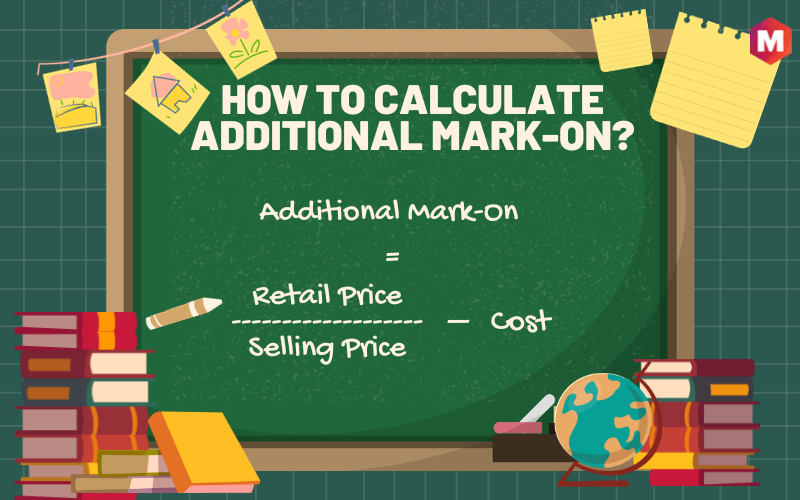Table of Contents
What is Additional Mark On?
Additional Mark-On is the difference between the selling price and production cost for a product. This is also known as the markup price. It is the extra amount that a company charges above the production cost to generate profit.
This Additional Mark-On covers not only profit but also any additional costs the company may incur, such as marketing, shipping, and overheads. Hence, it is crucial for the company’s sustainability and growth. It helps to generate profit, offsetting other costs and contributing to the company’s net revenue.
Key Takeaways!
- Additional mark-on allows for strategic pricing, helping businesses stay competitive while ensuring profitability.
- It ensures that costs beyond production, including marketing and overheads, are adequately covered.
- Higher additional mark-on can contribute significantly to a company’s net revenue, powering its growth and sustainability.
Why is Additional Mark-On Important?
In the context of a retail store, the Additional Mark-On becomes even more significant. The difference between retail price and cost price directly impacts the gross profit of a business owner. Understanding it helps to manage fixed and variable costs, thereby influencing the profit margin.
Some of the reasons behind the use of additional mark-on are:
- To cover fixed costs: Fixed costs are those that remain constant, regardless of the production volume. They include rent, insurance, salaries, etc. The additional mark-on helps to cover these costs while ensuring a profit.
- To account for variable costs: Variable costs vary based on the production volume. For instance, the cost of raw materials or packaging increases with an increase in production. The additional mark-on helps to account for such costs and maintain profitability.
- To factor in risks: Every business carries certain risks, such as market fluctuations or unforeseen events. A higher additional mark-on can help to mitigate these risks and safeguard the company’s financial health.
How to Calculate it?
To calculate the additional mark-on, we can use a simple formula:
Additional Mark-On = Retail Price/Selling Price – Cost
The selling price is the amount at which the product or service is sold to the customers, while the cost price is the total cost of production. The difference between these two gives us additional mark-on.
Examples
Let’s walk through a hypothetical example to understand additional Mark-On better:
- Consider a shoe manufacturing company, ABC Kicks, which makes designer sneakers. The production cost for one pair of sneakers is $50.
- ABC Kicks sells each pair of sneakers to retailers for $120. Therefore, the markup price or Additional Mark-On is $70 ($120 – $50).
How to Add a Markup Percent to a Product
Adding a markup percent to a product involves determining the percentage over the cost that you want as profit. The chosen percentage becomes the markup rate, which you apply to the cost price to calculate the retail or selling price. Here’s a step-by-step guide:
- Determine the cost of the product (e.g., $50 for ABC Kicks).
- Decide on the desired profit margin or markup percentage (e.g., 30%).
- Convert the markup percent to a decimal by dividing it by 100 (e.g., 30/100 = 0.3).
- Multiply the cost price by the markup percent (e.g., $50 * 0.3 = $15).
- Add the result to the cost price to calculate the selling price (e.g. $50 + $15 = $65).
- The additional mark-on would be the difference between the selling price and cost price, which in this example is $65 – $50 = $15.
Advantages
One of the main benefits of implementing additional mark-on strategies is the increase in profitability. It allows businesses to cover their costs more effectively and generate revenue. Here are a few other reasons why additional mark-on matters:
- It provides a cushion against unforeseen expenses or market fluctuations.
- It enables businesses to invest in their growth and expansion.
- It can help enhance the perceived value of their product or service.
- It offers flexibility in pricing strategy, enabling discounts and sales promotions without incurring losses.
Disadvantages
Despite the benefits, using additional mark-on strategies can also have potential downsides. Not all businesses or scenarios may benefit from such an approach; it’s crucial to understand the potential risks involved. Here are some of the challenges you might face:
- Overpriced products might deter consumers, especially in highly competitive markets.
- Excessive markups can tarnish the brand’s image, making it seem greedy or exploitative.
- It may not be sustainable in the long run, particularly if cost prices increase.
- There’s always a risk of losing customers to cheaper alternatives if the markup is perceived as unjustified.
Conclusion
Additional mark-on strategies can prove beneficial if utilized wisely. They can significantly bolster profit margins and foster business growth, but it’s crucial to price your products or services competitively to retain customer loyalty and reputation.
To strike a balance, it’s essential to consider various factors such as market demand, competition, cost of production, and consumer perception before implementing additional mark-on strategies.
FAQs
1) What is an additional mark-on strategy?
An additional mark-on strategy is a pricing approach where businesses add an extra margin to their cost price. This strategy helps businesses to cushion against unexpected expenses, invest in growth, and enhance product value.
2) How can I effectively implement an additional mark-on strategy?
To effectively implement an additional mark-on strategy, you should consider factors such as market demand, competition, production costs, and consumer perception. Striking a balance is key to ensuring competitive pricing while maximizing profits.
3) What are the potential risks of using additional mark-on strategies?
Some potential risks include deterring customers with overpriced products, damaging brand image through excessive markups, and losing customers to cheaper alternatives. It’s crucial to carefully assess and monitor your pricing strategy to avoid these risks.
Liked this post? Check out the complete series on Pricing
